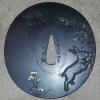
Peter Bleed
-
Posts
1,784 -
Joined
-
Last visited
-
Days Won
8

Peter Bleed last won the day on March 27 2023
Peter Bleed had the most liked content!
The recent visitors block is disabled and is not being shown to other users.
Peter Bleed replied to JAMJ's topic in Tosogu


Peter Bleed replied to 400 year old katana needs restorati's topic in Nihonto
Jeremiah,
I can't figure out how to sent you or the list the Kunikane Excel sheet? Please advise!
Peter

